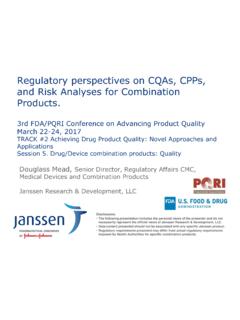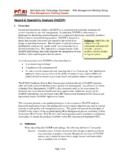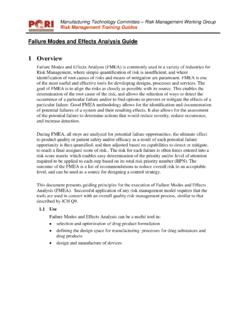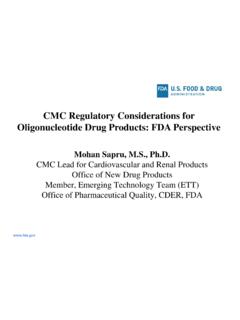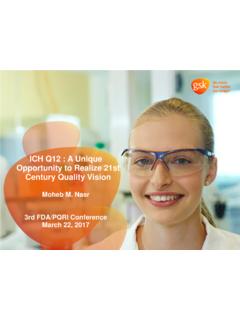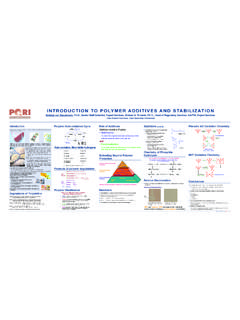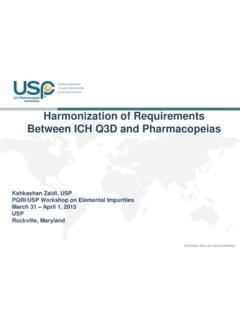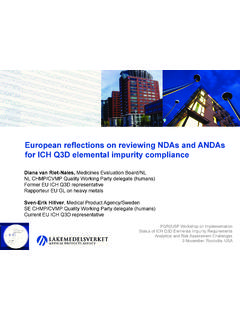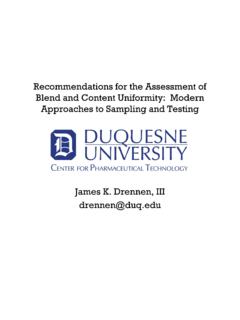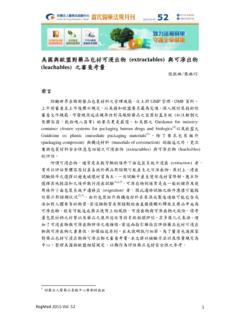Transcription of Parenteral and Ophthalmic Drug Products …
1 Parenteral and Ophthalmic drug Products leachables and Extractables working Group leachables in Parenteral and Ophthalmic drug Products (PODP) are those substances (both organic and inorganic) that are present in the drug product due to migration of substances from packaging systems (container closure systems, CCS). Such leachables are associated with the components or materials of construction of CCS that are in direct or indirect contact with the PODP. leachables typically correlate with extractables, which are those substances that can be extracted from the packaging system, and/or its associated components and materials of construction under experimental conditions, using appropriate solvents and extraction conditions.
2 Because some leachables may present potential safety and/or efficacy risks for final drug Products , regulatory guidance has provided some recommendations regarding the analysis and toxicological safety assessment ( , qualification) of such substances. These guidance documents have provided drug product sponsors with a high level strategic process to assess and qualify extractables and leachables in various dosage forms. Such a high level process involves four primary steps: Demonstrating that the materials of construction meet the relevant Compendial Monographs; Performing an extraction study to identify and, as appropriate, quantify all extractables; Performing a migration study to measure the levels of leachables in the PODP under conditions of use; and Performing a toxicological assessment of the extractables and/or leachables information to specifically address the safety impact of the specific leachables at their specific accumulation levels under the specific conditions and dosing associated with product use.
3 In September 2006, PQRI issued a Recommendation entitled "Safety Thresholds and Best Practices for Extractables and leachables in Orally Inhaled and Nasal drug Products ". This Recommendation provided a scientific rationale and process to identify, quantify, and establish the biological safety ( qualify) of leachables and/or extractables where appropriate, in OINDP. The fundamental concept proposed by PQRI was a Safety Concern Threshold (SCT) that would establish a level below which leachables are not considered for toxicological safety qualification, as any leachable existing at levels below this threshold would present minimal safety risk to the patient unless the leachable would be special case compound.
4 A Qualification Threshold (QT) would establish a level below which the leachable is not considered for safety qualification unless it presents structure-activity relationship (SAR) or other safety concerns. Both these thresholds assume that toxicological qualification should be performed on leachables and on a case by case basis for extractables. The SCT is used to develop an Analytical Evaluation Threshold (AET), which allows the SCT to be applied to leachables profiles of particular drug Products . The threshold concept utilizes a risk management approach which is consistent with the recommendations of PQRI and FDA guidance documents for container closure systems as well as the 2006 Guidance for Industry: Quality Systems Approach to Pharmaceutical CGMP Regulation.
5 In addition, the rationale for threshold concepts can be applied to support comprehensive studies for certain drug Products as outlined in the EMEA Guideline on Plastic Immediate of the PQRI PODP leachables and Extractables working Group Diane Paskiet, Director of Scientific Affairs, West Pharmaceutical Services, Chair Douglas J. Ball, Research Fellow, Pfizer, Inc., Toxicology Team Chair Dennis Jenke, Baxter Distinguished Scientist, Baxter Healthcare, Chemistry Team Chair: Frank Holcombe, Jr., US-FDA, PQRI Development Technical Committee Liaison: Chemistry Team Members: Jim Castner, , Pharma Interface Analysis, LLC. Thomas Egert, Boehringer Ingelheim Pharma GmbH & Co. KG Thomas Feinberg, , Director, Structural Chemistry, Catalent Pharma Solutions Alan Hendricker, , Principal Scientist, Catalent Pharma Solutions Christopher Houston, , Senior Principal Scientist, Bausch & Lomb Desmond G.
6 Hunt, , Scientist, Dept. of Standards Development, USP Michael Lynch, , Associate Research Fellow, Reg CMC, Pfizer Ingrid Markovic, , Special Advisor to the Associate Director for Review Management, Office of the Center Director, CBER, FDA Kumudini Nicholas, Team Leader, Pharmaceutical Quality Review, Bureau of Pharmaceutical Sciences, Health Canada Daniel L. Norwood, , , Distinguished Research Fellow, Boehringer Ingelheim Pharmaceuticals, Inc. Michael Ruberto, , Material Needs Consulting, LLC Edward J. Smith, , Packaging Science Resources, LLC Toxicology Team Members: Stephen A. Barat, , Senior Director, Toxicology and Operations, Forest Laboratories Steve Beck, CEMDD Liaison, GlaxoSmithKline William P.
7 Beierschmitt, , Associate Research Fellow, Pfizer, Inc. Abigail Jacobs, , Associate Director for Pharmacology/Toxicology, CDER, FDA Jacqueline A. Kunzler, , Director of Life Sciences Technology Resource Division, Baxter Healthcare Mary Richardson, , Executive Director, Preclinical Development, Bausch & Lomb Timothy Robison, Division of Pulmonary, Allergy, and Rheumatology Products , CDER, FDA Alisa Vespa, , Assessment Officer, Metabolism and Musculoskeletal Drugs Division, Bureau of Metabolism, Oncology and Reproductive Sciences, Therapeutic Products Directorate, Health Canada

